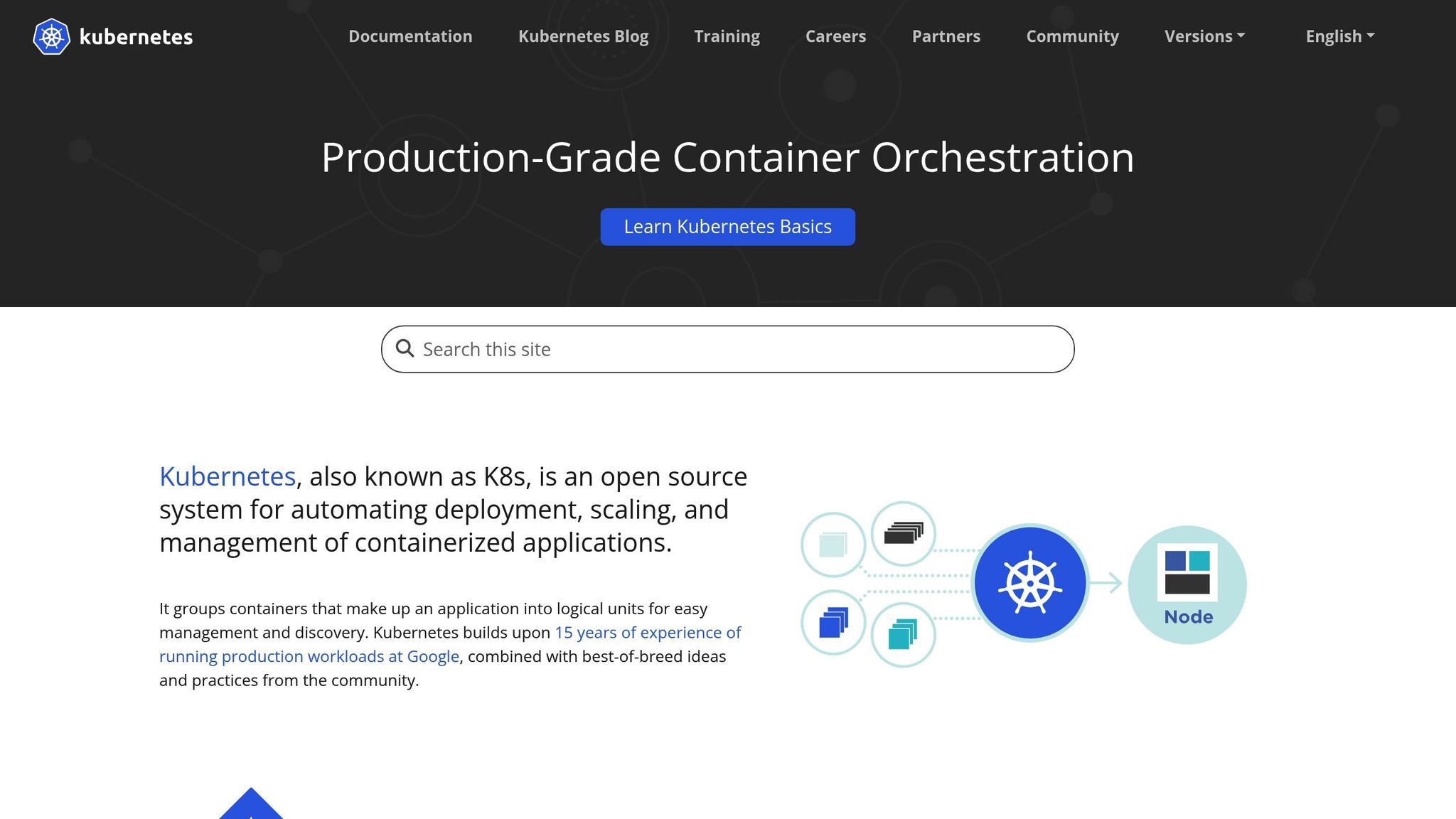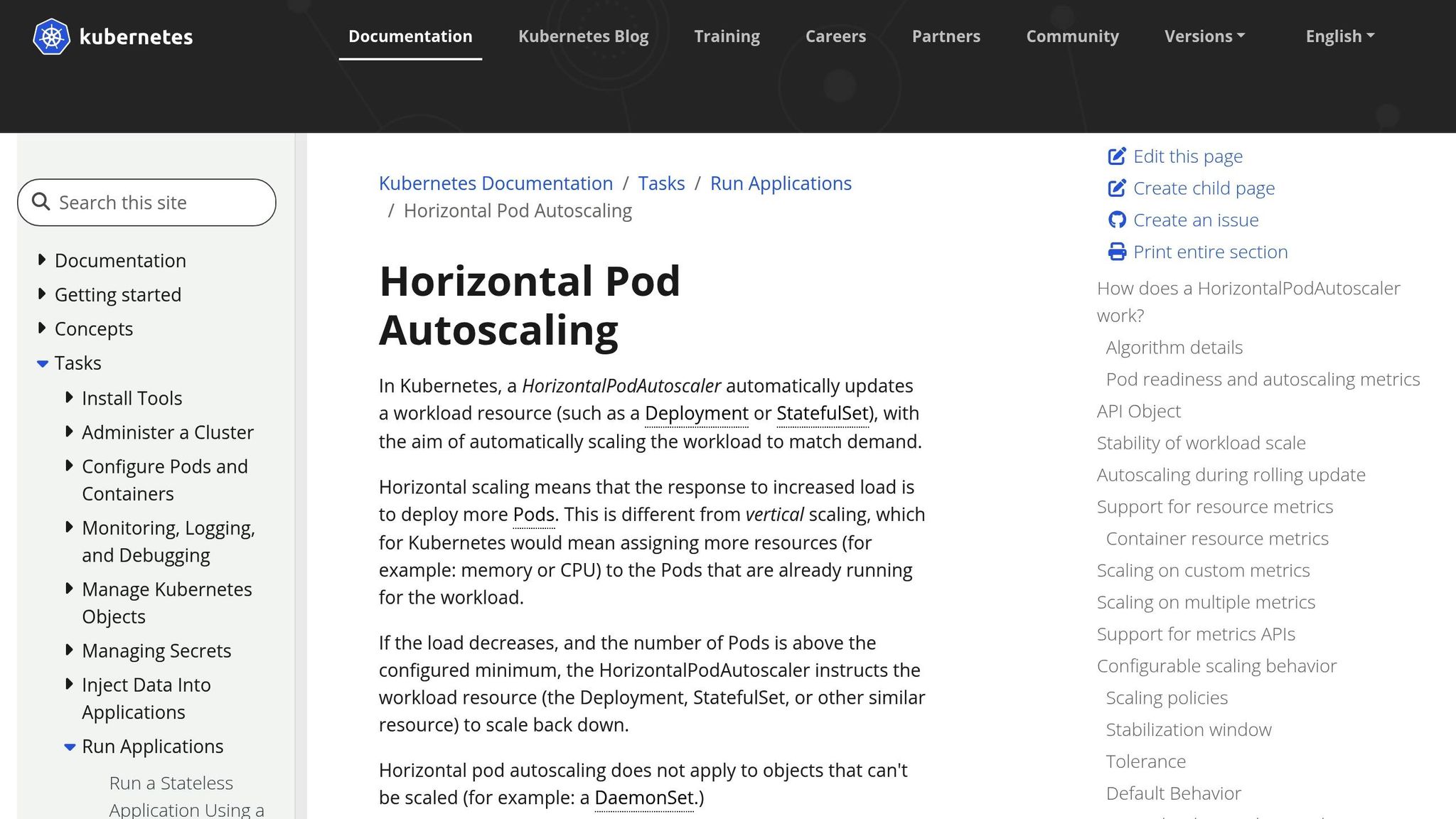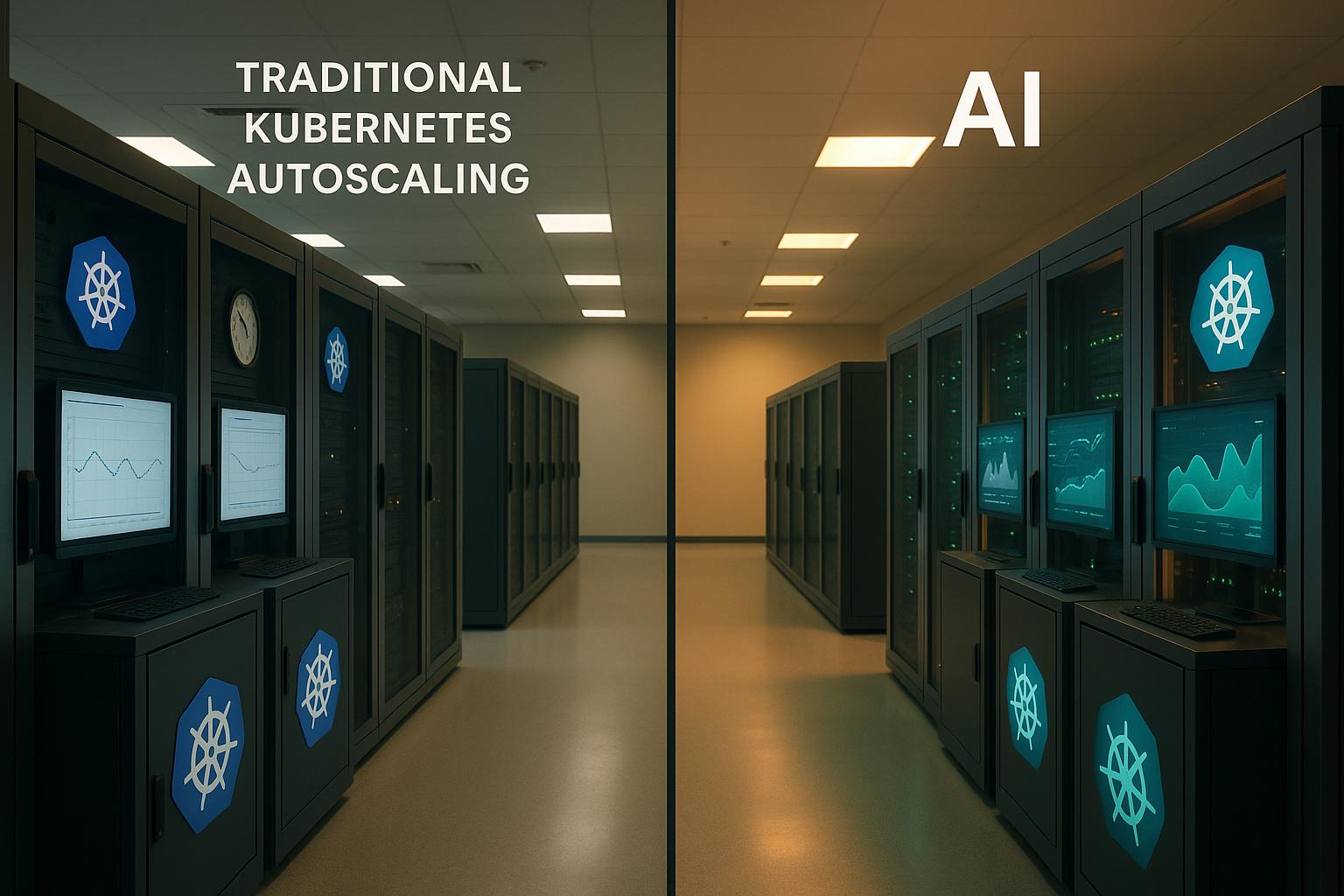Looking to optimise your Kubernetes scaling? Here's the gist:
- Traditional autoscaling relies on real-time metrics like CPU and memory usage to adjust resources reactively. It works well for predictable workloads but struggles with sudden traffic surges and can lead to resource inefficiencies.
- AI-driven scaling predicts future resource needs by analysing historical data and usage patterns. This proactive approach ensures smoother performance during demand spikes and reduces operational costs.
Key Points:
- Traditional methods use tools like HPA, VPA, and KEDA to scale resources based on immediate system conditions.
- AI-driven approaches forecast demand, allocating resources in advance to prevent delays and bottlenecks.
- For UK businesses, AI-driven scaling can help manage fluctuating traffic and reduce cloud costs by over 30%.
Quick Comparison
| Feature | Traditional Autoscaling | AI-Driven Scaling |
|---|---|---|
| Response | Reacts to current metrics | Predicts future demand |
| Cost Management | Risk of over-/under-provisioning | Optimises resource allocation |
| Performance | May lag during traffic surges | Ensures resources are ready beforehand |
| Setup Complexity | Simpler to implement | Requires historical data and AI models |
For UK organisations, the choice depends on workload predictability and infrastructure goals. A hybrid approach often works best, combining the reliability of traditional scaling with AI's forecasting capabilities.
Standard Kubernetes Autoscaling Methods

How Standard Autoscaling Works
Standard Kubernetes autoscaling operates by responding to the current state of the system. The Kubernetes metrics server collects data on resource usage every 15 seconds. When resource utilisation - typically CPU or memory - exceeds predefined thresholds (often set between 70–80%), the system either scales pods horizontally or adjusts their CPU and memory allocations vertically.
To prevent constant scaling due to temporary spikes or dips, cooldown periods are implemented. After a scaling event, the system waits for a set amount of time - usually 3 to 5 minutes for scaling up and 5 to 10 minutes for scaling down - before making further adjustments. This approach avoids excessive oscillation and ensures stability.
This method is fundamentally reactive, basing scaling decisions on the system's current state rather than anticipating future needs. While this works well for workloads that are consistent and predictable, it can struggle to keep up with sudden traffic surges or more complex usage patterns.
Next, let’s take a closer look at the tools that bring this approach to life.
Key Tools: HPA, VPA, and KEDA

Standard autoscaling relies on several tools to manage resources efficiently:
Horizontal Pod Autoscaler (HPA): HPA is the go-to tool for scaling Kubernetes workloads. It monitors metrics like CPU and memory usage and adjusts the number of pod replicas accordingly. By default, HPA aims for 80% CPU utilisation across all pods. If the average CPU usage exceeds this threshold, more replicas are created. When usage drops and stabilises below the target, unnecessary pods are removed to save resources. This tool is ideal for handling workloads that can be split across multiple pods.
Vertical Pod Autoscaler (VPA): Unlike HPA, VPA focuses on adjusting the resource requests and limits of individual pods instead of their quantity. It analyses historical resource usage to recommend or automatically apply optimal CPU and memory allocations. This is particularly useful for applications that cannot easily scale horizontally or when optimising resource use for existing pods is a priority.
Kubernetes Event-Driven Autoscaling (KEDA): KEDA goes beyond standard CPU and memory metrics, enabling scaling based on external events or custom metrics. For example, it can scale applications in response to queue lengths, HTTP request rates, database connections, or metrics from tools like Prometheus and Azure Monitor. KEDA is particularly suited for event-driven architectures, allowing applications to scale from zero replicas when no events are present. This makes it a great fit for organisations seeking serverless capabilities within Kubernetes environments.
Limitations of Standard Autoscaling
Despite its usefulness, standard Kubernetes autoscaling has some notable shortcomings:
Delayed Response Times: Since these systems react to current conditions rather than anticipating future demand, there’s always a lag between when resources are needed and when they become available. Factors like pod startup times, image pulling, and application initialisation can introduce delays ranging from 30 seconds to several minutes, potentially affecting performance during high-demand periods.
Basic Metric Reliance: Standard tools often depend heavily on CPU and memory metrics, which don’t always reflect the true state of an application. For instance, a web application might face slow response times due to database bottlenecks or external API delays, even if CPU usage remains low.
Over-Provisioning and Under-Provisioning: Setting thresholds too conservatively can lead to unnecessary resource use and higher costs, while overly aggressive thresholds risk performance issues during traffic spikes. Finding the right balance requires significant testing and constant fine-tuning, especially for applications with fluctuating workloads.
Struggles with Unpredictable Traffic: Standard autoscaling is effective for gradual load increases but often fails to handle sudden traffic surges - such as those caused by viral content, flash sales, or breaking news. By the time the system scales up, user experience might already be compromised.
Resource Waste: Scaling events often result in over-allocation of resources to ensure performance, leading to inefficiencies. This can be particularly challenging for UK businesses aiming to manage cloud costs effectively within tight budgets.
These limitations highlight the need for more advanced solutions, setting the stage for AI-driven methods that use predictive capabilities to address these challenges more effectively.
I Fixed Kubernetes Autoscaling using Machine Learning | ft. Keda & Prophet
AI-Driven Predictive Scaling for Kubernetes
Traditional autoscaling reacts to system metrics as they occur, but AI-driven predictive scaling takes it a step further by anticipating changes before they happen. By analysing historical data and forecasting demand, AI helps organisations with fluctuating traffic patterns allocate resources in advance. Instead of waiting for a performance drop to trigger scaling, these systems predict demand spikes and adjust resources proactively. This approach highlights how AI enhances the precision of autoscaling.
The Role of AI in Predictive Scaling
AI models are particularly skilled at uncovering patterns in historical data. They continuously assess external factors such as time of day, day of the week, seasonal trends, and events that could influence demand.
For example, machine learning algorithms can analyse how an e-commerce platform behaves during predictable traffic surges - like lunchtime shopping, evening browsing, or weekend sales. By recognising these patterns, AI systems can scale resources ahead of time, ensuring smooth performance when traffic increases.
AI also excels at identifying connections between different metrics. For instance, a rise in database connection requests might often precede a spike in web traffic. With this insight, the system can scale web servers proactively, avoiding potential slowdowns. This multi-layered analysis offers a more nuanced approach than traditional methods, which often rely on static thresholds.
What sets AI apart is its ability to adapt. As business needs evolve or new applications are introduced, these systems automatically refine their predictions using fresh data. This adaptability eliminates the need for constant manual adjustments by DevOps teams, keeping scaling decisions accurate and efficient.
Advanced Techniques in AI Scaling
AI's predictive capabilities are further enhanced by advanced techniques like time-series forecasting and reinforcement learning. These methods not only predict demand patterns but also refine scaling decisions based on real-world outcomes.
Anomaly detection algorithms work alongside predictive models to spot unusual traffic behaviours. If patterns deviate significantly from historical trends, the system can trigger alternative scaling measures or alert teams to investigate potential issues.
Some implementations use ensemble methods, where multiple AI models collaborate to improve prediction accuracy. One model might focus on weekly trends, another on seasonal fluctuations, and a third on real-time anomalies. By combining their insights, the system delivers more robust and reliable scaling outcomes.
Additionally, multi-objective optimisation algorithms help balance competing priorities like performance, cost, and resource efficiency. These systems aim to maintain performance standards while minimising infrastructure expenses - an especially useful feature for UK businesses operating under tight budgets.
Ahead-of-Time Resource Allocation
One of the standout benefits of AI-driven scaling is its ability to allocate resources before they’re urgently needed. This proactive approach prevents performance issues that can arise during reactive scaling, especially for applications with longer startup times or complex interdependencies.
This predictive approach also leads to smarter resource management. Instead of over-provisioning or scrambling to scale during sudden demand surges, AI systems allocate resources at the right time. Many organisations have seen noticeable reductions in infrastructure costs while simultaneously boosting application performance.
AI also enables coordinated scaling across multiple services. By synchronising the scaling of databases, caching layers, and application servers, the system avoids bottlenecks that could occur if only one component scales independently.
For UK businesses, this proactive strategy is invaluable during critical periods. Whether it’s managing traffic spikes during major events, responding to breaking news, or handling seasonal shopping rushes, AI-driven systems ensure resources are ready when needed. This not only protects user experience but also safeguards revenue streams.
Additionally, AI systems can fine-tune scaling decisions to account for geographic distribution, ensuring optimal performance for users across the UK and beyond. By adjusting resource allocation across availability zones or regions, businesses can deliver a seamless experience to their customers, no matter where they are located.
Need help optimizing your cloud costs?
Get expert advice on how to reduce your cloud expenses without sacrificing performance.
Comparison: Accuracy, Cost, and Resource Management
Let’s break down how traditional autoscaling compares to AI-driven predictive scaling in terms of efficiency, cost, and resource management.
Comparison Table
| Aspect | Standard Autoscaling | AI-Powered Predictive Scaling |
|---|---|---|
| Response | Reacts to current metrics | Anticipates future resource needs |
| Cost Efficiency | Risk of over- or under-provisioning | Optimises resource allocation, cutting unnecessary costs |
| Resource Management | Scales individual metrics independently, causing potential imbalances | Coordinates scaling across components for smoother performance |
This table captures the fundamental differences in how these methods operate.
Key Differences in Performance
Standard autoscaling operates reactively, meaning it adjusts resources only after detecting changes in demand. This can result in delays during sudden traffic spikes, potentially causing temporary performance hiccups during high-demand periods. For instance, if a website experiences an unexpected surge in visitors, traditional systems may struggle to scale up quickly enough to maintain seamless performance.
On the other hand, AI-powered predictive scaling takes a forward-thinking approach. By analysing historical data and patterns, it predicts future resource requirements and adjusts accordingly. This proactive method ensures that resources are available when needed, avoiding both over-provisioning and under-provisioning. The result? More accurate resource allocation and reduced operational costs.
Impact on UK Businesses
For UK organisations, these differences translate into real-world benefits. In a climate where controlling costs is more critical than ever, AI-driven scaling offers a way to trim cloud expenses by aligning resources precisely with demand. This means businesses can maintain a leaner, more efficient infrastructure without compromising performance.
Moreover, consistent performance during peak periods is non-negotiable for many UK companies. From Black Friday sales to seasonal demand spikes, having a system that can anticipate and prepare for increased traffic is invaluable. AI-driven scaling ensures that systems remain responsive, even under pressure, helping organisations avoid downtime or slowdowns during critical moments.
Another advantage? DevOps teams can focus on strategic initiatives rather than spending their time managing scaling adjustments. This shift allows teams to drive innovation and tackle more impactful projects, rather than being bogged down by routine tasks.
Implementation Requirements and Planning Considerations
To set up traditional autoscaling, you'll need a few basics in place:
Standard Autoscaling Requirements
- A solid understanding of Kubernetes concepts like Pods, Deployments, Services, and basic networking [1][3].
- Access to a live Kubernetes cluster [1][2].
Once these essentials are covered, organisations in the UK should also take time to evaluate additional planning aspects. This ensures the scaling strategy aligns with their specific operational goals and runs smoothly.
For more tailored advice on refining Kubernetes setups, Hokstad Consulting provides expert support in DevOps transformation and cloud infrastructure optimisation.
Conclusion: Choosing the Right Autoscaling Method
Key Takeaways
When it comes to autoscaling, traditional methods like HPA, VPA, and KEDA are often the go-to choices for predictable workloads. They’re straightforward, reliable, and help manage costs effectively. On the other hand, AI-driven predictive scaling shines in environments with unpredictable demand. By analysing patterns and proactively allocating resources, it reduces costs and ensures smooth operations. However, it does come with challenges, such as needing high-quality historical data and a more complex setup.
For UK businesses in regulated industries like finance or healthcare, traditional methods might feel like a safer bet due to their established track record. But for organisations experiencing rapid growth or dealing with seasonal spikes, AI-driven approaches can offer a significant edge by anticipating resource needs in advance.
Ultimately, the right choice depends on your specific workload and growth strategy. A hybrid approach often strikes the best balance, combining the reliability of traditional scaling with the adaptability of AI-driven enhancements. Many successful implementations use traditional methods as a baseline while leveraging AI for more dynamic workloads.
For UK organisations juggling fluctuating demand and limited budgets, finding the right autoscaling strategy is key to staying competitive.
How Hokstad Consulting Can Help
Making the right autoscaling decision can be complex, but expert guidance simplifies the process. Hokstad Consulting specialises in helping UK businesses navigate Kubernetes autoscaling, combining traditional DevOps expertise with cutting-edge AI technologies. Their proven strategies have helped clients cut cloud costs by 30-50% through tailored scaling solutions.
With a deep understanding of Kubernetes deployments, Hokstad Consulting offers bespoke solutions that meet the strict compliance requirements and evolving market conditions in the UK. Their services range from initial cloud cost audits to ongoing optimisation, ensuring your infrastructure is efficient and cost-effective.
One standout feature of their approach is their No Savings, No Fee
model for cost reduction services, providing a risk-free way to explore savings opportunities. They also excel in delivering zero-downtime cloud migrations and custom automation solutions, tailored to the needs of public, private, or hybrid cloud environments.
For UK organisations ready to optimise their Kubernetes infrastructure, Hokstad Consulting provides the expertise and tools needed to achieve long-term success.
FAQs
Why is AI-driven predictive scaling better at handling unexpected traffic surges compared to traditional Kubernetes autoscaling?
AI-powered predictive scaling takes resource management to the next level by using machine learning models and historical data to foresee demand. This proactive approach ensures resources are ready to handle traffic spikes before they happen, keeping systems running smoothly.
On the other hand, traditional autoscaling only kicks in after a surge has already occurred. This reactive method can result in delays, higher latency, or even system downtime. Predictive scaling not only avoids these issues but also strikes a balance between over-provisioning (wasting resources) and under-provisioning (causing performance hiccups). The result? A more seamless and cost-effective operation.
What are the advantages of combining traditional and AI-driven autoscaling for businesses in the UK?
A hybrid approach to autoscaling offers UK businesses the best of both worlds by blending traditional methods with AI-driven strategies. This combination ensures systems can respond instantly to real-time changes while also using predictive scaling to prepare for future workload shifts. The result? Smooth performance even during unpredictable demand spikes, all without wasting resources.
This method is especially beneficial for managing cloud costs in the UK, as it allocates resources more efficiently, reducing unnecessary expenses. On top of that, it provides the flexibility needed to adapt to shifting demands, maintaining reliability and performance without missing a beat.
What do you need to set up AI-driven predictive scaling in Kubernetes, and what challenges might you face?
To set up AI-driven predictive scaling in Kubernetes, you'll need to integrate AI models that can analyse both historical and real-time data to predict resource needs. This process involves thorough data collection, careful preprocessing, and training models to deliver precise forecasts.
However, there are some hurdles to tackle. Dealing with incomplete or noisy data can complicate predictions. It's also crucial to ensure your models are trained specifically for the workloads they will manage and fine-tuned for the best possible accuracy. Another consideration is the potential for delays in provisioning and resource allocation, which can impact performance if not addressed. Configuring scaling policies correctly and making ongoing adjustments to your models are key steps to overcoming these issues. When done right, this approach enables proactive scaling that improves resource efficiency and keeps costs in check.
